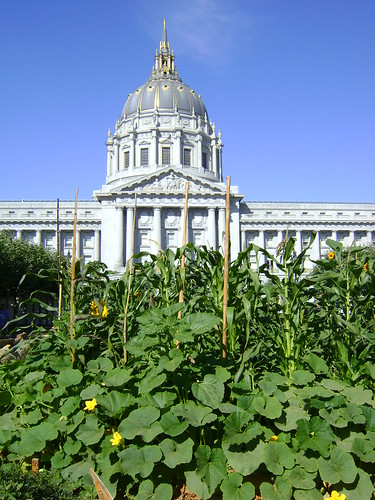I wrote this piece for the premier issue of Edible Los Angeles, which debuted this summer. It's long but relevant to this weekend's Slow Food Nation celebration in San Francisco. Hope to see you there.
 By Samuel Fromartz
By Samuel Fromartz
It was fall, the weather was turning cool, and I was getting desperate. I called around, quietly looking for a dealer. Then one Sunday, I ran into Eric over at the farmers’ market in Dupont Circle.
“So, you got any good shit?”
“Sure, but you got to come get it.”
The old story. The dealer never came to you. You had to go to the dealer.
But, then again, we’re talking about a lot of shit. A pick-up full, in fact. For if my community garden plot in the city was going to perk up in the spring, if I was going to get those fist-sized Chiogga beets and tender Russian kale, I had to work a pile of well-aged manure into the ground. And yes, this would be good, mind-blowing stuff, not skanky shit in a plastic bag. It was from a real farm, with real animals that ate real grass, and then sat, like fine wine, as it mellowed. Eric had it. In fact, he had so much he was willing to give it away. As long as we could come in a truck and get it.
I felt like I was working the back channels to keep my garden going, but then it’s not easy growing your own food in the city—as so many locavores are now finding out. Still, it was well worth it, because by going local, as in six-block-local, I was completing the third step in forging a connection with my food.
Over the years, organic wasn’t enough. Local wasn’t enough. I had to get my hands dirty and grow my own.
It wasn’t as if I set out with a plan, or a program, though I now realize it’s all part of a natural progression (I won’t go so far as to say “purpose,” but maybe it’s that too) from Whole Foods to the farmers market to the garden.
The initial spark came when I found myself routinely jockeying for a parking spot in the Whole Foods parking lot. Consumers like me were clearly responding to something being sold here and I wanted to find out what it was. Sticker shock did nothing to dissuade my purchases— if anything, it enhanced them because I saw real value, not cost.
And from there, in search of ever more quality local and organic produce, I ended up at the farmers’ market and quickly became a devotee.
Looking into the evolution of my personal impulses, I saw I wasn’t alone—like others, I was responding to something in the air that morphed good food, fresh produce, organics, and the farmers’ face into a movement and an industry. That became the focus of my book, Organic Inc., but flying around the country visiting farms just whet my appetite.
Seeing so many people grow so much food in so many places made me think, “I could do this!” I signed up for a plot at a new community garden inWashington, D.C., just as I was wearily finishing my 300-plus page manuscript.
With farmers’ markets bursting with seasonal produce, you might rightfully ask, “Why even try?” I mean, local and organic seem to be everywhere. There are many reasons not to, especially in the city. I could list what’s going against you, from getting a garden plot itself (which, in one of my two locations, took 8 years), to preparing the tired soil littered with brick and concrete, to battling wire-like weeds, to engaging, in near hand-to-hand combat, the counterinsurgency of rats. Then, you must be Zen about food theft.
Plus, it takes time. I’m not a trustifarian. I’ve got a real, if self-designed, job, with too many projects, and a demanding family life, but I take the time to grow food because it feeds me in a lot of ways. In fact, I don’t even view growing food as “food production” per se but rather as a way to take my hands off the MacBook and put them in the soil, to spend precious time with my daughter, and while away the twilight hours as the cars whiz by over the nearby freeway. By doing this, you opt out of any food “system,” whether industrial, or agrarian. You become your own food system (as least so far as your veggies go).
The only downside of this ultra-local move is that it produces an ensuing syndrome, which I call Farmers Market Guilt. I depended on farmers who were my friends—who I once bought copious amounts of food from, to the tune of $50 a week—for advice to grow my own.
They willingly emailed local planting schedules and tips on beating bugs, preparing the soil, building a compost pile, growing seedlings and all the rest. In fact, their advice proved so profitable that I no longer visited them at the farmers’ market! When I admitted my guilt about that, one of my farmer friends said simply, “I’ve got a lot of other people to buy my vegetables” and left it at that. He knew most people weren’t going to get down in the dirt.
Which is okay. Because sustainability is not a series of steps, or a program or list of procedures. There’s not one way to get it right. Fred Kirschenmann, a distinguished fellow at the Leopold Center for Sustainable Agriculture at the University of Iowa, speaks of sustainability as a philosophy or consciousness. Local may be a part of that; so too organics.
And people enter the continuum at various points: whether buying a few organic food items at the supermarket, becoming a regular at farmers’ markets, or looking for a well-aged pile of shit for their garden.
What’s next? I’ve been intrigued by the way Alaska has managed its fisheries, so that there’s a plentiful and sustainable supply. Maybe it’s worth a visit up there. I’m also curious about the way oyster farms actually filter and clean seawater and provide a stellar seafood product. “Maybe we should start an oyster farm,” I said to my wife the other day as we finished up dinner. She just looked at me, as usual, amused.
© Samuel Fromartz 2008, reproduction for personal or non-commercial use only


